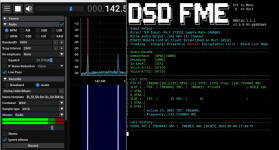Hi again guys so I'm running just the basic :
dsd-fme-aero.exe -i tcp 7355
command via sdr++ sink
I have a VHF trunked Cap+ system on 165mhz and have all the frequencies and lcns from my scanner.
How would I go about scanning those frequencies and logging the data from them? I edited the cap+ csv with the frequencies and I'm getting an error similar to cannot find channel_map.csv (which I'm sure I had to create and fill with the said Cap+ freqs.
What I would do is make your csv file (see the cap sample in the examples folder) with your LSNs enumerated in it and save it in the examples folder. I find its easier to just save all your csv files in there since all the bat file examples show how to link to that directory, and just call it with the -C examples\capacity_plus_chan.csv (backslash in windows, forward slash in linux) or whatever you end up naming the file. For Capacity Plus, make sure that channels 1 and 2 are the same frequency (they are LSN based and not LCN), 3 and 4 the same, up to how many logical slots that system has.
For trunking it, I would make sure the rigctl server is turned on inside of SDR++ running on its default port of 4532, and then run the command, or just copy and paste it into your bat file.
dsd-fme-aero.exe -i tcp:localhost:7355 -U 4532 -T -t 2 -C examples\capacity_plus.chan.csv
A lot of the trunking examples are found in the 'start with pulse audio' bat file. While using pulse audio isn't required, if its a busy TDMA system where you may often get voice on both slots simultaneously, I would recommend using it. The OSS implementation can't do both voices at the same time (it stutters if allowed to try) the pulse audio backend can do it just fine, it just requires the user to start the pulse audio backend first, then launch dsd-fme from the bat file with pulse audio (or by using the command switch '-o pulse' after the pulse audio server backend is started.
EDIT: Added the `-t 2` option to tell it to hold on an RF frequency for 2 seconds of hangtime, the default is 1, but some capacity plus systems have a longer interval between beaconing and need to dwell a little longer before jumping to the next channel looking for the rest channel.





